Phytosterol
Phytosterols, which encompass plant sterols and stanols, are phytosteroids similar to cholesterol which occur in plants and vary only in carbon side chains and/or presence or absence of a double bond. Stanols are saturated sterols, having no double bonds in the sterol ring structure. More than 200 sterols and related compounds have been identified.[1] Free phytosterols extracted from oils are insoluble in water, relatively insoluble in oil, and soluble in alcohols.
Phytosterol-enriched foods and dietary supplements have been marketed for decades. Despite well documented LDL cholesterol lowering effects, no scientifically proven evidence of any beneficial effect on cardiovascular disease (CVD) or overall mortality exists.[2]
Structure
| β-sitosterol | campesterol | cholesterol |
|---|---|---|
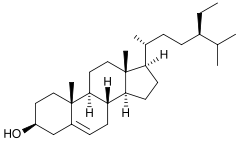 | 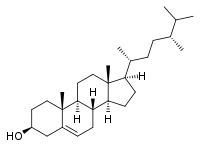 | 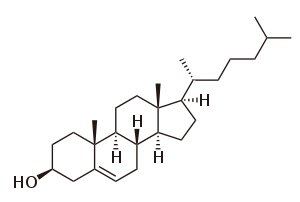 |
| stigmasterol | Stigmastanol | |
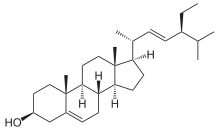 |  |

The molecule on the left is β-sitosterol. Nomenclature for steroid skeleton is on the right.
- By removing carbon 242, campesterol is obtained.
- By removing carbons 241 and 242, cholesterol is obtained.
- Removing a hydrogen from carbons 22 and 23 yields stigmasterol (stigmasta-5,22-dien-3β-ol).
- By hydrogenating the double bond between carbons 5 and 6, β-sitostanol (Stigmastanol) is obtained.
- By hydrogenating the double bond between carbons 5 and 6 and removing carbon 242, campestanol is obtained.
- Removing carbon 242 and hydrogens from carbons 22 and 23, and inverting the stereochemistry at C-24 yields brassicasterol (ergosta-5,22-dien-3β-ol).
- Further removal of hydrogens from carbons 7 and 8 from brassicasterol yields ergosterol (ergosta-5,7,22-trien-3β-ol). Important: Ergosterol is not a plant sterol. Ergosterol is a component of fungal cell membranes, serving the same function in fungi that cholesterol serves in animal cells.
- Esterification of the hydroxyl group at carbon 3 with fatty/organic acids or carbohydrates results in plant sterol esters, i.e. oleates, ferulates and (acyl) glycosides.
- Actually, Lupeol is a triterpenoid, not strictly a sterol; it is not a gonane.
| campestanol | brassicasterol | ergosterol |
|---|---|---|
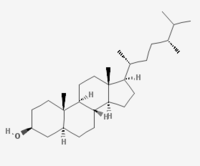 |  |  |
| lupeol | cycloartenol | |
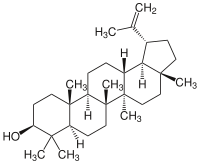 |  |
Dietary phytosterols
The richest naturally occurring sources of phytosterols are vegetable oils and products made from them. They can be present in the free form and as esters of fatty acid/cinnamic acid or as glycosides, respectively. The bound form is usually hydrolyzed in the small intestines by pancreatic enzymes.[3] Nuts, which are rich in phytosterols, are often eaten in smaller amounts, but can still significantly contribute to total phytosterol intake. Cereal products, vegetables, fruit and berries, which are not as rich in phytosterols, may also be significant sources of phytosterols due to their higher intakes.[4]
The intake of naturally occurring phytosterols ranges between ~200-300 mg/day depending on eating habits.[5] Specially designed vegetarian experimental diets have been produced yielding upwards of 700 mg/day.[6] The most commonly occurring phytosterols in the human diet are β-sitosterol, campesterol and stigmasterol, which account for about 65%, 30% and 3% of diet contents, respectively.[7] The most common plant stanols in the human diet are sitostanol and campestanol, which combined make up about 5% of dietary phytosterol.[8]
Health claims
EFSA
The European Foods Safety Authority (EFSA) concluded that blood cholesterol can be reduced on average by 7 to 10.5% if a person consumes 1.5 to 2.4 grams of plant sterols and stanols per day, an effect usually established within 2–3 weeks. Longer-term studies extending up to 85 weeks showed that the cholesterol-lowering effect could be sustained.[9] Based on this and other efficacy data, the EFSA scientific panel provided the following health advisory: “Plant sterols have been shown to lower/reduce blood cholesterol. Blood cholesterol lowering may reduce the risk of coronary heart disease".[10]
FDA
The FDA has approved the following claim for phytosterols: For plant sterol esters: (i) Foods containing at least 0.65 g per serving of plant sterol esters, eaten twice a day with meals for a daily total intake of at least 1.3 g, as part of a diet low in saturated fat and cholesterol, may reduce the risk of heart disease. A serving of [name of the food] supplies ___grams of vegetable oil sterol esters.[11] For plant stanol esters: (i) Foods containing at least 1.7 g per serving of plant stanol esters, eaten twice a day with meals for a total daily intake of at least 3.4 g, as part of a diet low in saturated fat and cholesterol, may reduce the risk of heart disease. A serving of [name of the food] supplies ___grams of plant stanol esters.[12] Reviewing clinical trials involving phytosterol supplementation, the FDA concluded that when consumed in the range of 1 to 3 grams in enriched foods, phytosterols resulted in statistically significant (5-15%) reductions in blood LDL cholesterol levels relative to placebo. The FDA also concluded that a daily dietary intake of 2 grams a day of phytosterols (expressed as non-esterified phytosterols) is required to demonstrate a relationship between phytosterol consumption and cholesterol lowering for reduced CVD risk.[13]
Health Canada
Health Canada reviewed the evidence of 84 randomized controlled trials published between 1994-2007 involving phytosterol supplementation. An average 8.8% reduction in LDL-cholesterol was observed at a mean intake of 2 grams per day.[14] Health Canada concluded that sufficient scientific evidence exists to support a relationship between phytosterol consumption and blood cholesterol lowering. Based on this evidence, Health Canada approved the following statements for qualifying foods intended for hypercholesterolemic individuals: Primary statement: "[serving size from Nutrition Facts table in metric and common household measures] of [naming the product] provides X% of the daily amount* of plant sterols shown to help reduce/lower cholesterol in adults." Two additional statements that could be used in combination or alone, adjacent to the primary statement, without any intervening printed, written or graphic material: "Plant sterols help reduce [or help lower] cholesterol." This statement when used, shall be shown in letters up to twice the size and prominence as those of the primary statement. "High cholesterol is a risk factor for heart disease." This statement when used, shall be shown in letters up to the same size and prominence as those of the primary statement.
Cholesterol lowering
The ability of phytosterols to reduce cholesterol levels was first demonstrated in humans in 1953.[15][16] From 1954-82, phytosterols were subsequently marketed as a pharmaceutical under the name Cytellin as a treatment for elevated cholesterol.[17]
Unlike the statins, where cholesterol lowering has been proven to reduce CVD risk and overall mortality under well-defined circumstances, no such effect has ever been documented with phytosterol-enriched foods or supplements.[2][18] While cholesterol lowering was frequently used as a surrogate endpoint for beneficial effects on CVD, examples exist where specific medications for cholesterol lowering were found to have no significant effect on clinical endpoints, such as with ezetimibe.
Coadministration of statins with phytosterol-enriched foods increases the cholesterol-lowering effect of phytosterols, again without any proof of clinical benefit and with anecdotal evidence of potential adverse effects.[2]
Statins work by reducing cholesterol synthesis via inhibition of the rate-limiting HMG-CoA reductase enzyme. Phytosterols reduce cholesterol levels by competing with cholesterol absorption in the gut via one or several possible mechanisms,[19][20][21] an effect that complements statins. Phytosterols further reduce cholesterol levels by about 9% to 17% in statin users.[22] The type or dose of statin does not appear to affect the cholesterol-lowering efficacy of phytosterols.[23]
Because of their cholesterol reducing properties, some manufacturers are using sterols or stanols as a food additive.[24]
In preliminary research, phytosterol intake lowered triglyceride levels in people with familial hypertriglyceridemia.[25]
Safety
Phytosterols have a long history of safe use dating back to Cytellin, the pharmaceutical preparation of phytosterols marketed in the US from 1954-82.[17] Phytosterol esters have generally recognized as safe (GRAS) status in the US.[26] Phytosterol-containing functional foods were subject to postlaunch monitoring after being introduced to the EU market in 2000, and no unpredicted side effects were reported.[27]
A potential safety concern regarding phytosterol consumption is in patients with phytosterolaemia, a rare genetic disorder which results in a 50- to 100-fold increase in blood plant sterol levels and is associated with rapid development of coronary atherosclerosis. Phytosterolaemia has been linked to mutations in the ABCG5/G8 proteins which pump plant sterols out of enterocytes and hepatocytes into the lumen and bile ducts, respectively. Plant sterol levels in the blood have been shown to be positively, negatively or not associated with CVD risk, depending on the study population investigated.[28][29][30][31][32][33][34][35]
The link between plant sterols and CVD or CHD risk is complicated because phytosterol levels reflect cholesterol absorption. (See Phytosterols as a marker for cholesterol absorption).
Sterol vs stanol
The equivalent ability and safety of plant sterols and plant stanols to lower cholesterol continues to be a hotly debated topic. Plant sterols and stanols, when compared head to head in clinical trials, have been shown to equally reduce cholesterol levels.[36][37][38] A meta-analysis of 14 randomized, controlled trials comparing plant sterols to plant stanols directly at doses of 0.6 to 2.5 g/day showed no difference between the two forms on total cholesterol, LDL cholesterol, HDL cholesterol, or triglyceride levels.[39] Trials looking at high doses (> 4 g/day) of plant sterols or stanols are very limited, and none have yet to be completed comparing the same high dose of plant sterol to plant stanol.
The debate regarding sterol vs. stanol safety is centered on their differing intestinal absorption and resulting plasma concentrations. Phytostanols have a lower estimated intestinal absorption rate (0.02 - 0.3 %) than phytosterols (0.4 - 5 %) and consequently blood phytostanol concentration is generally lower than phytosterol concentration.[2]
Research
Phytosterols are under preliminary research for their potential to inhibit lung, stomach, ovarian and breast cancers,[40][41] as well as colon and prostate cancers.[42]
References
- ↑ Akhisa, T.; Kokke, W. (1991). "Naturally occurring sterols and related compounds from plants". In Patterson, G. W.; Nes, W. D. Physiology and Biochemistry of Sterols. Champaign, IL: American Oil Chemists' Society. pp. 172–228.
- 1 2 3 4 Weingartner, O.; Bohm, M.; Laufs, U. (2008). "Controversial role of plant sterol esters in the management of hypercholesterolaemia". European Heart Journal. 30 (4): 404–9. PMC 2642922
 . PMID 19158117. doi:10.1093/eurheartj/ehn580.
. PMID 19158117. doi:10.1093/eurheartj/ehn580. - ↑ Moreau RA, Hicks KB (2004). "The in vitro hydrolysis of phytosterol conjugates in food matrices by mammalian digestive enzymes". Lipids. 39 (8): 769–76. PMID 15638245.
- ↑ Valsta, L. M.; Lemström, A.; Ovaskainen, M.-L.; Lampi, A.-M.; Toivo, J.; Korhonen, T.; Piironen, V. (2007). "Estimation of plant sterol and cholesterol intake in Finland: Quality of new values and their effect on intake". British Journal of Nutrition. 92 (4): 671–8. PMID 15522137. doi:10.1079/BJN20041234.
- ↑ Jesch ED, Carr TP (2017). "Food Ingredients That Inhibit Cholesterol Absorption". Prev Nutr Food Sci. 22 (2): 67–80. PMC 5503415
 . PMID 28702423. doi:10.3746/pnf.2017.22.2.67.
. PMID 28702423. doi:10.3746/pnf.2017.22.2.67. - ↑ Ågren, J. J.; Tvrzicka, E.; Nenonen, M. T.; Helve, T.; Hänninen, O. (2007). "Divergent changes in serum sterols during a strict uncooked vegan diet in patients with rheumatoid arthritis". British Journal of Nutrition. 85 (2): 137–9. PMID 11242480. doi:10.1079/BJN2000234.
- ↑ Weihrauch, JL; Gardner, JM (1978). "Sterol content of foods of plant origin". Journal of the American Dietetic Association. 73 (1): 39–47. PMID 659760.
- ↑ Andersson, S W; Skinner, J; Ellegård, L; Welch, A A; Bingham, S; Mulligan, A; Andersson, H; Khaw, K-T (2004). "Intake of dietary plant sterols is inversely related to serum cholesterol concentration in men and women in the EPIC Norfolk population: A cross-sectional study". European Journal of Clinical Nutrition. 58 (10): 1378–85. PMID 15054420. doi:10.1038/sj.ejcn.1601980.
- ↑ European Food Safety Authority. "Blood cholesterol reduction health claims on phytosterols can now be judged against EFSA new scientific advice".
- ↑ European Food Safety Authority. "Plant Sterols and Blood Cholesterol - Scientific substantiation of a health claim related to plant sterols and lower/reduced blood cholesterol and reduced risk of (coronary) heart disease pursuant to Article 14 of Regulation (EC) No 1924/2006[1]" (PDF).
- ↑ FDA. "Health claims: plant sterol/stanol esters and risk of coronary heart disease (CHD)".
- ↑ FDA. "Health claims: plant sterol/stanol esters and risk of coronary heart disease (CHD)".
- ↑ FDA. "Food Labeling; Health Claim; Phytosterols and Risk of Coronary Heart Disease; Proposed Rule" (PDF).
- ↑ Health Canada. "Plant Sterols and Blood Cholesterol Lowering" (PDF).
- ↑ Pollak, OJ (1953). "Reduction of blood cholesterol in man". Circulation. 7 (5): 702–6. PMID 13042924. doi:10.1161/01.CIR.7.5.702.
- ↑ Tilvis, RS; Miettinen, TA (1986). "Serum plant sterols and their relation to cholesterol absorption". The American Journal of Clinical Nutrition. 43 (1): 92–7. PMID 3942097.
- 1 2 Jones, PJ (2007). "Ingestion of phytosterols is not potentially hazardous". The Journal of Nutrition. 137 (11): 2485; author reply 2486. PMID 17951490.
- ↑ Genser, B.; Silbernagel, G.; De Backer, G.; Bruckert, E.; Carmena, R.; Chapman, M. J.; Deanfield, J.; Descamps, O. S.; Rietzschel, E. R.; Dias, K. C.; März, W. (2012). "Plant sterols and cardiovascular disease: A systematic review and meta-analysis". European Heart Journal. 33 (4): 444–451. PMC 3279314
 . PMID 22334625. doi:10.1093/eurheartj/ehr441.
. PMID 22334625. doi:10.1093/eurheartj/ehr441. - ↑ Nguyen, Tu T. (1999). "The Cholesterol-Lowering Action of Plant Stanol Esters". The Journal of Nutrition. The American Society for Nutritional Sciences. 129 (12): 2109–2112. Retrieved 10 April 2015.
- ↑ Trautwein, Elke A.; Duchateau, Guus S. M. J. E.; Lin, Yuguang; Mel'nikov, Sergey M.; Molhuizen, Henry O.F.; Ntanios, Fady Y. (2003). "Proposed mechanisms of cholesterol-lowering action of plant sterols". European Journal of Lipid Science and Technology. 105 (3-4): 171–185. doi:10.1002/ejlt.200390033. Retrieved 16 April 2015.
- ↑ De Smet, E; Mensink, RP; Plat, J (2012). "Effects of plant sterols and stanols on intestinal cholesterol metabolism: suggested mechanisms from past to present". Molecular Nutrition & Food Research. 56 (7): 1058–72. PMID 22623436. doi:10.1002/mnfr.201100722.
- ↑ Scholle, JM; Baker, WL; Talati, R; Coleman, CI (2009). "The effect of adding plant sterols or stanols to statin therapy in hypercholesterolemic patients: Systematic review and meta-analysis". Journal of the American College of Nutrition. 28 (5): 517–24. PMID 20439548. doi:10.1080/07315724.2009.10719784.
- ↑ Katan, M. B.; Grundy, S. M.; Jones, P.; Law, M.; Miettinen, T.; Paoletti, R.; Stresa Workshop, Participants (2003). "Efficacy and Safety of Plant Stanols and Sterols in the Management of Blood Cholesterol Levels". Mayo Clinic Proceedings. 78 (8): 965–78. PMID 12911045. doi:10.4065/78.8.965.
- ↑ Griffin, RM (Feb 2, 2009). "The New Low-Cholesterol Diet: Plant Sterols and Stanols: What are sterols and stanols, and does anyone like to eat them?". http://webmd.com. WebMD. Retrieved 6 July 2013. External link in
|website=(help) - ↑ Moruisi KG, Oosthuizen W, Opperman AM (2006). "Phytosterols/stanols lower cholesterol concentrations in familial hypercholesterolemic subjects: a systematic review with meta-analysis". J Am Coll Nutr. 25 (1): 41–8. PMID 16522931. doi:10.1080/07315724.2006.10719513.
- ↑ FDA. "GRAS Notice 000181: Phytosterols" (PDF).
- ↑ Lea, L.J.; Hepburn, P.A. (2006). "Safety evaluation of phytosterol-esters. Part 9: Results of a European post-launch monitoring programme". Food and Chemical Toxicology. 44 (8): 1213–22. PMID 16542769. doi:10.1016/j.fct.2006.01.017.
- ↑ Silbernagel, G.; Fauler, G.; Renner, W.; Landl, E. M.; Hoffmann, M. M.; Winkelmann, B. R.; Boehm, B. O.; Marz, W. (2008). "The relationships of cholesterol metabolism and plasma plant sterols with the severity of coronary artery disease". The Journal of Lipid Research. 50 (2): 334–41. doi:10.1194/jlr.P800013-JLR200.
- ↑ Silbernagel, G.; Fauler, G.; Hoffmann, M. M.; Lutjohann, D.; Winkelmann, B. R.; Boehm, B. O.; Marz, W. (2010). "The associations of cholesterol metabolism and plasma plant sterols with all-cause and cardiovascular mortality". The Journal of Lipid Research. 51 (8): 2384–93. PMC 2903788
 . PMID 20228406. doi:10.1194/jlr.P002899.
. PMID 20228406. doi:10.1194/jlr.P002899. - ↑ Strandberg, Timo E.; Gylling, Helena; Tilvis, Reijo S.; Miettinen, Tatu A. (2010). "Serum plant and other noncholesterol sterols, cholesterol metabolism and 22-year mortality among middle-aged men". Atherosclerosis. 210 (1): 282–7. PMID 19962145. doi:10.1016/j.atherosclerosis.2009.11.007.
- ↑ Fassbender, Klaus; Lütjohann, Dieter; Dik, Miranda G.; Bremmer, Marijke; König, Jochem; Walter, Silke; Liu, Yang; Letièmbre, Maryse; Von Bergmann, Klaus (2008). "Moderately elevated plant sterol levels are associated with reduced cardiovascular risk—The LASA study". Atherosclerosis. 196 (1): 283–8. PMID 17137582. doi:10.1016/j.atherosclerosis.2006.10.032.
- ↑ Rajaratnam, Radhakrishnan A; Gylling, Helena; Miettinen, Tatu A (2000). "Independent association of serum squalene and noncholesterol sterols with coronary artery disease in postmenopausal women". Journal of the American College of Cardiology. 35 (5): 1185–91. PMID 10758959. doi:10.1016/S0735-1097(00)00527-1.
- ↑ Assmann, Gerd; Cullen, Paul; Erbey, John; Ramey, Dena R.; Kannenberg, Frank; Schulte, Helmut (2006). "Plasma sitosterol elevations are associated with an increased incidence of coronary events in men: Results of a nested case-control analysis of the Prospective Cardiovascular Münster (PROCAM) study". Nutrition, Metabolism and Cardiovascular Diseases. 16 (1): 13–21. PMID 16399487. doi:10.1016/j.numecd.2005.04.001.
- ↑ Sudhop, Thomas; Gottwald, Britta M.; Von Bergmann, Klaus (2002). "Serum plant sterols as a potential risk factor for coronary heart disease". Metabolism. 51 (12): 1519–21. PMID 12489060. doi:10.1053/meta.2002.36298.
- ↑ Pinedo, S.; Vissers, M. N.; Bergmann, K. v.; Elharchaoui, K.; Lutjohann, D.; Luben, R.; Wareham, N. J.; Kastelein, J. J. P.; Khaw, K.-T.; Boekholdt, S. M. (2006). "Plasma levels of plant sterols and the risk of coronary artery disease: The prospective EPIC-Norfolk Population Study". The Journal of Lipid Research. 48: 139–44. doi:10.1194/jlr.M600371-JLR200.
- ↑ Hallikainen, M A; Sarkkinen, E S; Gylling, H; Erkkilä, A T; Uusitupa, M I J (2000). "Comparison of the effects of plant sterol ester and plant stanol ester-enriched margarines in lowering serum cholesterol concentrations in hypercholesterolaemic subjects on a low-fat diet". European Journal of Clinical Nutrition. 54 (9): 715–25. PMID 11002384. doi:10.1038/sj.ejcn.1601083.
- ↑ O'Neill, F.H.; Brynes, A.; Mandeno, R.; Rendell, N.; Taylor, G.; Seed, M.; Thompson, G.R. (2004). "Comparison of the effects of dietary plant sterol and stanol esters on lipid metabolism". Nutrition, Metabolism and Cardiovascular Diseases. 14 (3): 133–42. doi:10.1016/S0939-4753(04)80033-4.
- ↑ Vanstone, CA; Raeini-Sarjaz, M; Parsons, WE; Jones, PJ (2002). "Unesterified plant sterols and stanols lower LDL-cholesterol concentrations equivalently in hypercholesterolemic persons". The American Journal of Clinical Nutrition. 76 (6): 1272–8. PMID 12450893.
- ↑ Talati, Ripple; Sobieraj, Diana M.; Makanji, Sagar S.; Phung, Olivia J.; Coleman, Craig I. (2010). "The Comparative Efficacy of Plant Sterols and Stanols on Serum Lipids: A Systematic Review and Meta-Analysis". Journal of the American Dietetic Association. 110 (5): 719–26. PMID 20430133. doi:10.1016/j.jada.2010.02.011.
- ↑ Ramprasath, VR; Awad, AB (2015). "Role of Phytosterols in Cancer Prevention and Treatment." (PDF). Journal of AOAC International. 98 (3): 735–8. PMID 26086253. doi:10.5740/jaoacint.SGERamprasath.
- ↑ Woyengo, T.A.; Ramprasath, V.R.; Jones, P.J.H. (June 2009). "Anticancer effects of phytosterols". European Journal of Clinical Nutrition. 63: 813–820. PMID 19491917. doi:10.1038/ejcn.2009.29. Retrieved 10 December 2016.
- ↑ Bradford, P.G.; Awad, A.B. (February 2007). "Phytosterols as anticancer compounds". Molecular Nutrition & Food Research. 51 (2): 161–170. doi:10.1002/mnfr.200600164. Retrieved 10 December 2016.